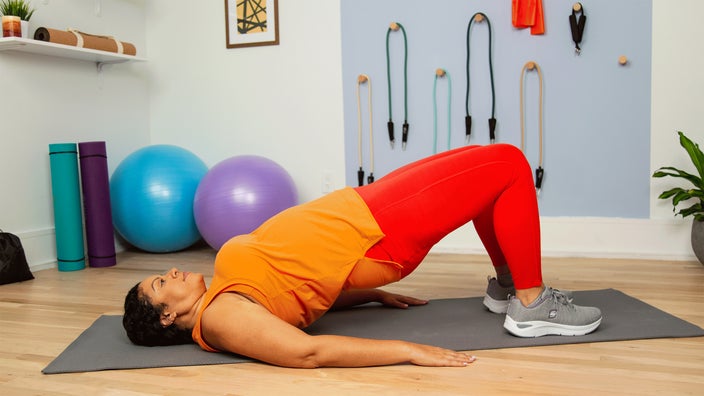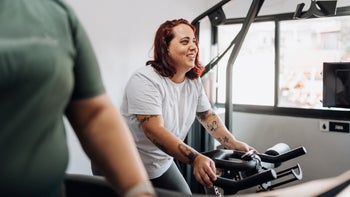
The 5 Best Stretches and Exercises for Lower Back Pain Relief
Key takeaways:
Lower back pain affects most people at least once in their lives.
Repetitive strain from overuse and age-related changes can cause lower back pain.
The best stretches for lower back pain are designed to ease tension and increase flexibility. Regular stretching and strengthening your core muscles can prevent and relieve lower back pain.
Table of contents

Is your lower back feeling stiff or achy? You’re not alone. Up to 80% of people experience back pain at some point in their lives.
Back pain can hinder your ability to work and do the activities you enjoy. The good news is that exercise –– including stretches, strengthening moves, and aerobics –– can relieve lumbar ( lower back) pain. A regular exercise routine may also help prevent back pain from recurring.
What are the best stretches for lower back pain?
The best stretches for lower back pain engage multiple muscle groups in your back and core.
Save over 40% on Qsymia with GoodRx
Discover the once daily Qsymia for weight management. Qsymia is for adults and children 12-17 in combination with a healthy diet and regular exercise.

It’s always a good idea to talk to a healthcare professional before starting a new exercise program. This is especially important if you have a health condition, a recent injury, or acute lower back pain.
Once a healthcare professional gives you the OK, you can slowly add these lower back stretches and exercises to your routine. Keep all movements within a pain-free range. If you try these exercises during a flare-up of chronic lower back pain — with a healthcare professional’s approval — you may feel a pulling sensation or mild discomfort. But stop immediately if you feel sharp pain or if symptoms like back pain or numbness in your leg worsen.
If you’re in pain, start slowly with gentle stretches. If you don’t usually exercise or stretch, consider working with a physical therapist before trying these moves on your own.
1. Cat-cow
The cat-cow stretch is a great exercise for beginners. This yoga pose increases flexibility and mobility in your spine while gently stretching the surrounding muscles.
Step 1: Start on all fours with your hands and knees hip-width apart. Make sure your hands are aligned with your shoulders and your knees are aligned with your hips.
Step 2: Exhale as you round your back, pushing your spine up toward the ceiling. Tuck your head in and draw your belly button toward your spine. Hold for 5 seconds.
Step 3: Inhale as you arch your back, dropping your belly toward the floor. Extend your neck to look toward the ceiling. Hold for 5 seconds.
Step 4: Repeat this movement 10 times in both directions.
2. Single knee-to-chest

This stretch targets your hip flexors along the front of your thighs and the muscles along your spine. It also helps improve the mobility of your lower back.
Step 1: Lie on your back with your legs straight and your heels resting on the floor.
Step 2: Bring your right knee toward your chest, gently pulling on the back of your thigh to deepen the stretch. You should feel the stretch in the front of your left hip and lower back.
Step 3: Hold this position for 5-10 seconds, then relax.
Step 4: Repeat on the left side, feeling the stretch in your right hip and lower back.
Step 5: Do the same on the other side, repeating 10 times on each side.
Prolonged sitting can wreak havoc on your back. Get research-backed tips to prevent back pain while sitting at your desk.
It’s hard to fall or stay asleep with back pain. Fortunately, these sleeping positions can reduce the strain on your back and help you catch some z’s.
Yoga poses can help relieve back pain and stiffness. Try gentle poses to soothe lower back pain.
3. Pelvic tilt

Pelvic tilts are a basic core-strengthening move. This subtle movement activates deep abdominal muscles, helping to stabilize your spine and maintain a neutral position.
Step 1: Lie on your back with your knees bent and your feet flat on the floor.
Step 2: Engage your core by pressing your lower back toward the floor, tucking your hips under, and drawing your belly button into your spine. This will tilt your pelvis slightly, and you should feel tension in your abdominal muscles.
Step 3: Hold this engagement in your core for 5 seconds, then relax.
Step 4: Repeat 20 times.
4. Glute bridge

This exercise helps strengthen your glutes. These are powerful hip muscles that move your legs and stabilize your pelvis and spine. Weak glutes can lead to muscle imbalances, increasing stress on your lower back.
Step 1: Lie on your back with your feet flat on the floor and your knees bent.
Step 2: Press your lower back into the floor to engage your core and maintain a neutral spine.
Step 3: Keeping your back straight, lift your hips off the floor.
Step 4: Squeeze your glutes and draw your belly button toward your spine to keep your core engaged.
Step 5: Hold the bridge for 5-10 seconds. Then, slowly lower your hips back to the starting position.
Step 6: Complete 20 repetitions.
Read more like this
Explore these related articles, suggested for readers like you.
5. Bird dog

This core-strengthening exercise challenges your abdominals to stabilize your spine as you simultaneously lift your opposite arm and leg. It helps improve strength, core stability, and balance.
Step 1: Start on all fours with your hands and knees hip-width apart. Make sure your hands are aligned with your shoulders and your knees with your hips.
Step 2: Engage your core by drawing your belly button toward your spine. Keep your neck and spine in a neutral position.
Step 3: Slowly extend your right arm forward and your left leg backward at the same time, maintaining your balance. Your arm and leg should be parallel to the floor and your spine should remain straight.
Step 4: Return to the starting position, then repeat the movement with your left arm and right leg.
Step 5: Alternate between sides, completing 20 repetitions on each side.
Are there other lower back exercises to relieve pain?
Yes, numerous exercises for lower back pain may help ease tension or prevent it altogether. This includes strengthening exercises, stretches, and yoga poses such as:
Child’s pose: Kneel on a yoga mat with your knees wide but your feet together. Sit back on your heels and extend your arms forward, resting your forehead on the mat.
Seated spinal twist: Sit tall with your legs extended. Bend your right knee and cross it over your left leg. Twist your torso to the right, placing your left arm outside your bent knee and your right arm on the floor behind you for support.
Downward dog: Start on all fours. Tuck your toes and lift your hips up and back. Walk your feet back a few inches until your body forms an upside-down V-shape.
Sphinx pose: Lie on your stomach with your legs extended and feet hip-width apart. Lift up onto your forearms and raise your chest, keeping your elbows under your shoulders.
Happy baby pose: Lie on your back with your knees bent and feet flat on the mat. Bring your knees toward your chest and grab the soles of your feet, keeping your back flat on the mat.
Forward fold: Stand tall with your hands on your hips. Hinge at your hips to bend forward, bringing your torso toward your thighs. Cross your arms as you hold the forward fold.
Figure 4 piriformis stretch: Lie on your back, cross your right ankle over your left knee, and gently pull your left leg toward your chest. Repeat on the other side.
Supine spinal twist: Lie on your back with your arms at your sides, knees bent, and feet flat on the floor. Keep your shoulders on the floor as you drop your knees to one side.
What causes lower back pain?
Most lower back pain is acute, or short-term, and will resolve in about 4 weeks. If your pain lasts longer than 12 weeks, it’s considered chronic.
Both chronic and acute lower back pain affect people of all ages. But as you get older, your chances of having lumbar pain increase for various reasons. Studies show that muscles, ligaments, spinal discs, and other soft tissues lose flexibility with age. This can cause muscle imbalances and restricted movement, leading to back pain.
In addition to age-related changes, injuries and certain health conditions can cause lower back pain. Common causes include:
Muscle strain: Muscle strains that affect the muscles and ligaments in your spine account for 70% of lower back pain cases. Lifting something too heavy, repeating the same movements (overuse), and sitting for prolonged periods can strain your back.
Herniated disc: A herniated disc can cause discomfort in your lower back. It can also lead to pain or numbness in your legs (also called sciatica). The condition occurs when the disc material in your spine bulges, possibly putting pressure on your spinal cord and nerves.
Spondylosis: This is a common cause of pain and stiffness in the low back. Spondylosis refers to osteoarthritis in the spine, which is more common with age.
Spinal stenosis: This condition occurs when the spinal canal narrows, leaving less space for your spinal cord and nerves. Spinal stenosis causes lower back pain, as well as pain, numbness, and tingling down your legs.
How does stretching help with lower back pain?
As we’ve discussed, stretching and core-strengthening exercises can help keep your back healthy. Specifically, stretching and strengthening exercises –– including those that target your back, hamstrings, hip flexors, and glutes –– may help:
Boost blood flow to the joints and soft tissues in your back
Increase flexibility and range of motion
Sustain functional movement
Maintain the natural curvature of your spine
Frequently asked questions
It depends. Gentle stretching can often help relieve mild lower back pain, as long as you keep the moves in a pain-free range of motion. But avoid stretching and talk to a healthcare professional if:
You had a recent back injury
You have sharp, intense, or worsening back pain
You have back pain that radiates to other areas
You have back pain with tingling, numbness, or weakness
Always listen to your body and consult a healthcare professional when in doubt.
Opt for gentle, low-impact stretches in bed to relax your lower back and surrounding muscles. Examples include:
Child’s pose
Supine spinal twist
Lying down is generally better than sitting when you have lower back pain because it can reduce pressure on your spine. But try to avoid prolonged sitting, standing, or lying down during the day, as doing so may worsen symptoms. Regular movement can help prevent stiffness.
When you lie down, try one of the following positions to help ease discomfort:
Lie on your side with a pillow between your slightly bent knees
Lie on your side in a fetal position
Lie on your back with a pillow under your knees
Lie on your stomach with a pillow under your pelvis
The bottom line
Most people will experience lower back pain –– from overuse, injury, or various health conditions –– at some point in their lives. Luckily, routine stretching can help you maintain flexibility and soothe or prevent lower back pain. A well-rounded exercise routine that includes aerobics and core-strengthening moves can also help keep your back healthy and strong.
Why trust our experts?



References
Alo Moves. (2019). How to do corpse pose | Savasana tutorial with Briohny Smyth [video]. YouTube.
American Council on Exercise. (n.d.). Downward-facing dog.
Children’s Hospital Colorado. (2017). Core exercise: Supine twist [video]. YouTube.
CORE Chiropractic. (2019). Seated spinal twist - core chiropractic exercises [video]. YouTube.
DICK’S Sporting Goods. (2018). How to do happy baby pose [video]. YouTube.
Konrad, A., et al. (2021). The influence of stretching the hip flexor muscles on performance parameters: A systematic review with meta-analysis. International Journal of Environmental Research and Public Health.
Magill, S. (2024). Osteoarthritis. American Association of Neurological Surgeons.
Martin, B. I., et al. (2014). Back pain in the United States. Variation in the Care of Surgical Conditions: Spinal Stenosis: A Dartmouth Atlas of Health Care Series. The Dartmouth Institute for Health Policy and Clinical Practice.
Medibank. (2016). How to do a child’s pose stretch [video]. YouTube.
Medibank. (2016). How to do a piriformis stretch [video]. YouTube.
Open Fit. (2021). How to do the reclined butterfly pose | Openfit [video]. YouTube.
Paolucci, T., et al. (2018). Chronic low back pain and postural rehabilitation exercise: A literature review. Journal of Pain Research.
Park, D. K. (2021). Lumbar spinal stenosis. OrthoInfo.
Park, S., et al. (2018). Longer sitting time and low physical activity are closely associated with chronic low back pain in population over 50 years of age: A cross-sectional study using the sixth Korea National Health and Nutrition Examination Survey. The Spine Journal.
Qaseem, A., et al. (2017). Noninvasive treatments for acute, subacute, and chronic low back pain: A clinical practice guideline from the American College of Physicians. Annals of Internal Medicine.
Shiri, R., et al. (2018). Exercise for the prevention of low back pain: Systematic review and meta-analysis of controlled trials. American Journal of Epidemiology.
The Yoga Collective. (n.d.). Knees to chest pose – apanasana.
Vive Health. (2019). Sphinx pose for core strength [video]. YouTube.
Will, J. S., et al. (2018). Mechanical low back pain. American Family Physician.
Wong, A. Y. L., et al. (2017). Low back pain in older adults: Risk factors, management options and future directions. Scoliosis and Spinal Disorders.
Yoga Journal. (2018). Standing forward bend [video]. YouTube.





























